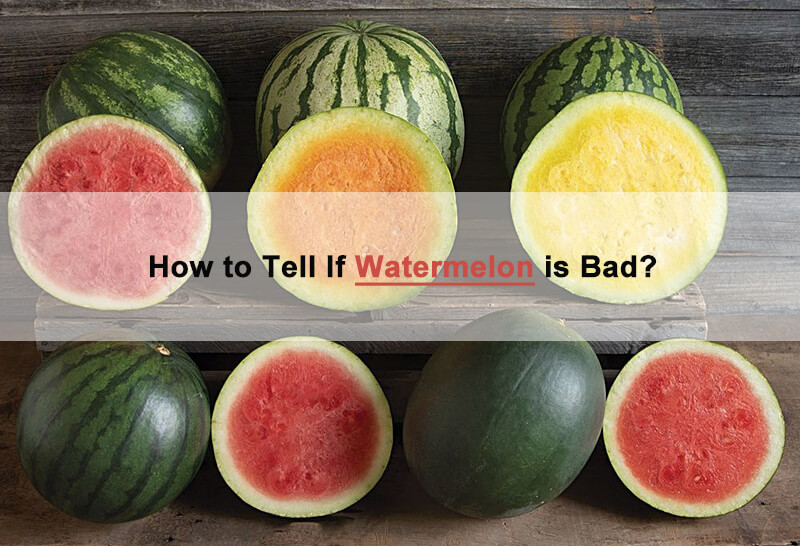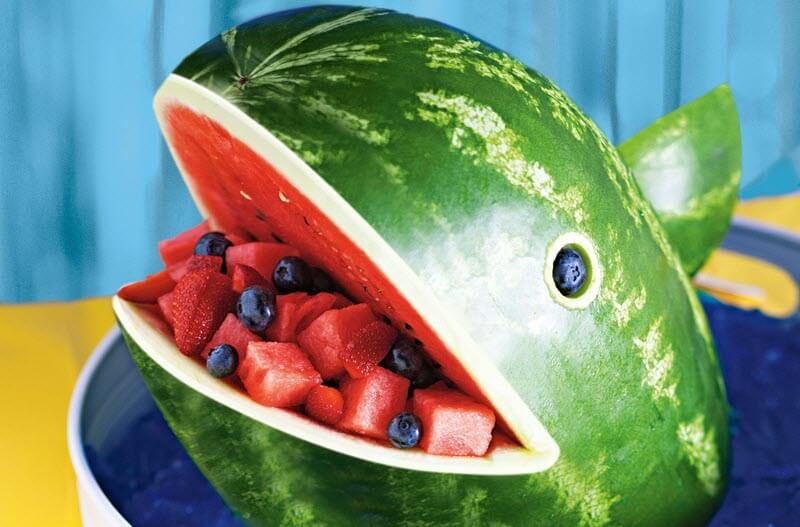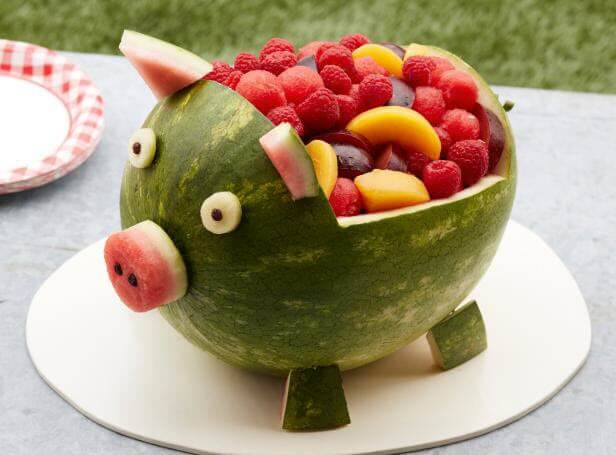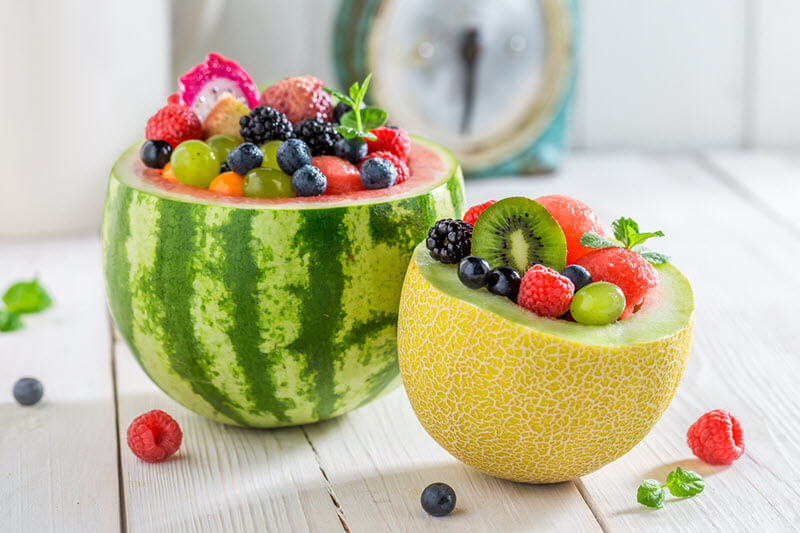“When one has tasted watermelon, he knows what the angels eat.” — Mark Twain.
Watermelons are juicy! So, we can’t fault Mark Twain for how he felt.
Although juicy and heavenly, watermelons can go bad. If that happens, how can you tell when your watermelon is bad? Stick around for these juicy details.
Table Of Contents
30-Second Summary
- Watermelons can go bad, and the best way to tell is through their color, smell, taste, and texture.
- To get the best out of your watermelons, only cut them when you are ready to eat them. Once it’s cut, always refrigerate.
- Uncut watermelon can last for about 3 weeks at room temperature.
- Cut watermelons last for three days in the refrigerator.
- Avoid watermelons that are soft or contain nitrates.
- Once you notice your watermelon is bad, discard it immediately.
Can Watermelon Go Bad?
Yes. Sadly, this juicy red fruit can go bad. Watermelons are delicate fruits, so it shouldn’t surprise you that they go rancid quickly.
Unlike most fruits that have a considerable shelf life, watermelon does not. Farmers know how delicate this succulent fruit is; they only harvest this gourd when it’s near its ripening peak.
How Long Can Watermelon Last?
How Long is Watermelon Good for | |||
Watermelon | Room temperature | Fridge | Freezer |
Cut | 1 day | About 3 days | 8 to 10 months |
Uncut | 7 to 10 days | Up to 3 weeks | Up to 1 year |
- Uncut watermelons can last for about ten days at room temperature. Ensure you keep away from heat.
- In the fridge, uncut watermelons can last for up to 3 weeks.
- Cut watermelon stays in the fridge for about 3 days.
How to Tell If Watermelon is Bad
To determine if your watermelon is bad, follow these suggestions.
How to Tell If Uncut Watermelon is Bad
If you are working with uncut watermelons, look out for these signs:
Mold on the Body
These molds usually appear as dark spots on the exterior of the melons. They are pretty easy to spot.
Color
Typically, the body of watermelons has alternating light and dark green stripes; or a consistent shade of pine green. Any color that deviates from this might indicate that your fruit is bad.
Tap and Listen
A deep sound indicates your watermelon is still good. A hollow sound shows it’s bad.
Check the Texture
Press the gourd gently but firmly; if it feels soft instead of hard, it’s best to dispose of it.
How You Can Tell If Watermelon is Bad After Cutting
Smell
Smell the watermelon. If you perceive a bad aroma, you have to throw it away.
Color
Take note of the color of the watermelon’s flesh. Any color that deviates from the norm is a red flag, depending on the variety.
Taste
Taste a tiny portion, if it’s sour and tangy. Then you might have to buy new melons.
Appearance
If you notice a hole in the middle, it could be overripe and unsuitable for eating.
What’s more, if the watermelon flesh is shriveled and slimy, it’s going bad. Sometimes the seeds are already detached from the flesh.
What Does Bad Watermelon Look like?
Bad watermelon looks unattractive and different from healthy, safe fruit.
The whole fruit should be smooth and firm to the touch, with no holes or bruises. You have probably picked up a dud if a cut into the fruit reveals a hollow center.
What Does Bad Watermelon Taste Like?
A bad watermelon typically has a sour taste. It also has a coarse and slimy texture.
How to Store Watermelon
Refrigeration
You can store watermelons in the refrigerator. But keep in mind that refrigeration reduces the nutritional benefits and affects the look after a while.
Additionally, make sure the watermelon is clean and free from bacteria and dirt. Then cut them up and store them in zip-lock bags. This method applies if you are working with watermelons and their rinds.
However, if you wish to refrigerate your watermelon slices without the rind, de-seed them before storing them in sealable bags or airtight containers. This way, you preserve the flavor and freshness.
Freezing
Freezing watermelons extends their shelf life. Use an ice tray or popsicle mold to make ice cubes of blended watermelons.
You can add seasoning or blend it with other fruits to make frozen treats if you feel adventurous.
Pickling
Yes, we know it sounds strange, but you can store your watermelons by Pickling.
It’s pretty straightforward; all you need to do is:
- Get some lemon juice, vinegar, sugar, and spice. Then boil them.
- Next, slice your watermelon and put them in mason jars [1].
- Pour the cooked mixture inside the jars and cover. Allow to cool and store in your kitchen pantry.
Candying and Jellying
You can store your watermelons by turning them into candied treats or jellies. This form lasts longer than storing fresh watermelons.
Let’s talk about the downside of eating an old watermelon.
Fun Fact About Watermelons
Are you a lover of watermelon? Do you know all about this succulent gourd?
- Watermelons contain 92 percent water and 6percent sugar. A befitting name for this fruit. So next time someone asks you, “what percentage of water is in a watermelon?” You know what to say!
- Every part of a watermelon is edible. Yes, including the seeds. So don’t worry if you swallow any seeds while munching.
- Watermelons exist in over 1200 varieties worldwide.
- The watermelon is a favored gift to bring to a host in Japan and China.
Frequently Asked Questions
What happens if you eat old watermelon?
Like eating other rotten fruits, you run the risk of food poisoning. Signs like headache, nausea, vomiting, fatigue, and diarrhea.
Is soft watermelon bad?
When your watermelon is soft, it is an indication that it’s overripe, apart from the lack of texture and less flavor.
Overripe fruits can breed bacteria quickly as they are already showing signs of spoilage. Consuming them might lead to abdominal discomfort.
At this point, let’s answer a few questions about watermelons.
Can you freeze watermelon?
Absolutely! You can freeze watermelons. It’s best, however, to freeze cut watermelons.
What’s the difference between red and yellow watermelon?
The compound lycopene [2] makes the difference. Red watermelon has it, but yellow watermelon doesn’t. Its also found in tomatoes.
Can you eat an unripe watermelon?
You can if you want to. However, it’s advisable not to; it isn’t as flavorful as ripe watermelons.
How to tell there is nitrate in a watermelon?
If the rind of your red watermelon is yellow instead of white, then it contains nitrates.
To test it for nitrate, cut a little piece of flesh and place it in a jar of water. If the water turns pinkish or red after some time, your watermelon has nitrates in it. It’s meant to remain the same color with water.
Final Words
Juicy, succulent watermelon, just like other refreshing fruits, you can never get enough of it.
Remember to avoid watermelons that are soft and contain nitrate. Choose right and stay healthy!






